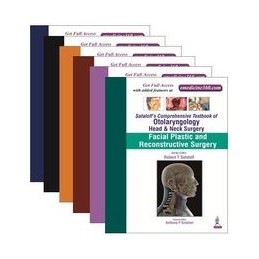Volume I - Otology/Neurotology/Skull Base Surgery
- Anatomy and Physiology of the Auditory System
- Evaluation of Auditory Function
- Middle Ear Mechanics in Normal Hearing, Diseased Ears, and in Hearing Reconstruction
- Anatomy and Physiology of the Vestibular System
- Evaluation of Vestibular Function
- Anatomy and Physiology of the Eustachian Tube
- Radiology of the Temporal Bone
- Diseases of the External Ear
- Neoplasms of the Temporal Bone
- Non-Squamous Cell Carcinoma Tumors of the Temporal Bone
- Cholesteatoma
- Tympanic Membrane Perforation and Tympanoplasty
- Complications of Temporal Bone Infection
- Otosclerosis
- Tumors of the Middle Ear
- Sensorineural Hearing Loss
- Presbyacusis
- Occupational Hearing Loss
- Ototoxicity
- Tinnitus
- Menieres Disease
- Temporal Bone Trauma
- Vestibular Schwannoma
- Meningioma and Other Non-Vestibular Schwannoma Tumors of the CPA
- Jugular Bulb in Ear Diseases
- Encephalocele and CSF Leak
- Presbystasis and Balance in the Elderly
- Inner Ear Dehiscence
- Peripheral Vertigo
- Central Vertigo
- Aural Rehabilitation and Hearing Aids
- Implantable Middle Ear and Bone Conduction Devices
- Cochlear Implantation
- Auditory Brainstem Implants
- Inner Ear Therapy/Drug Delivery Systems
- Anatomy and Physiology of the Facial Nerve
- Facial Nerve Testing
- Facial Nerve Paralysis
- Facial Nerve Tumors
- Facial Nerve Rehabilitation
Volume II - Rhinology/Allergy & Immunology
Section 1. History of Rhinology
- History of Rhinology - From Ancient Times to the 21st Century
Section 2. Embryology, Anatomy and Physiology
- Evolution of the Human Nasal Respiratory Tract:: Nose and Paranasal Sinuses
- Embryology and Development of the Nose and Paranasal Sinuses
- Anatomy of the Nose and Paranasal Sinuses
- Nasal Physiology
Section 3. Evaluation of The Nose And Paranasal Sinuses
- Clinical Evaluation of the Nose and Paranasal Sinuses
- Rhinometry and Acoustic Rhinometry
- Clinical Evaluation and Treatment of Smell and Taste Disorders
- Diagnostic Imaging in Rhinology
- Measuring Quality of Life and Outcomes in Rhinology
- Practice Management, Coding and Career Pathways in Rhinology
Section 4. Allergy
- Epidemiology and Pathophysiology of Allergic Rhinitis
- Evaluation and Diagnostic Testing of Allergic Rhinitis
- Treatment of Allergic Rhinitis
- Allergy, Reactive Airway Disease and Rhinosinusitis:: The Unified Airway
Section 5. Disorders of the Nose
- Granulomatous and Inflammatory Diseases of the Nose and Paranasal Sinuses
- Fibro-osseous Lesions
- Benign Neoplasms of the Nose and Paranasal Sinuses
- The Nose and Sleep Disorders
- Sinonasal Effects of Drugs and Toxins
- Epistaxis
- Headache and Facial Pain
Section 6. Rhinosinusitis:: Etiology, Pathophysiology And Medical Therapy
- Classification and Diagnosis of Rhinosinusitis
- The Pathogenesis of Rhinosinusitis
- Genetic Basis of Rhinosinusitis
- Immunologic Aspects of Rhinosinusitis
- Acute Rhinosinusitis
- Bacteria in Rhinosinusitis:: Infection, Biofilms and Super Antigens
- Nasal Polyposis
- Fungus in Paranasal Sinus Disease
- Osteitis
- Odontogenic Sinusitis
- Reflux and Sinusitis
- Complications of Rhinologic Disorders
- Antibiotic Therapy in Rhinosinusitis
- Anti-inflammatory Therapy in Rhinosinusitis
Section 7. Anesthesia
- Complementary Therapy and Integrative Medicine in Sinonasal Disease
- Refractory Chronic Rhinosinusitis
Section 8. Functional Surgery of the Nasal Airway
- Local Anesthesia
- General Anesthesia
- Surgery of the Nasal Septum
Section 9. Surgery for Inflammatory Sinusitis
- Surgical Management of the Nasal Turbinates
- Functional Rhinoplasty
- Office-Based Rhinologic Procedures
- Endoscopic Sinus Surgery for Chronic Rhinosinusitis:: Historical Evolution, Indications and Outcomes
- Training for Sinonasal Surgery:: Past, Present and Future
- Innovations in Optics and Instrumentation
- Surgical Radiology and Image Guidance
- Primary Endoscopic Sinus Surgery for Chronic Rhinosinusitis
- Revision Endoscopic Sinus Surgery
- Endoscopic Surgery of the Frontal Sinus
- Minimally Invasive Sinus Surgery and Balloon Sinuplasty
- Open Approaches to the Paranasal Sinuses for Inflammatory Sinusitis
- Section 10. Endoscopic Skull Base Surgery
- Odontogenic Disease and Oral-Antral Fistula
- Complications of Endoscopic Sinus Surgery
- Endoscopic Surgery of the Sella and Suprasellar Region
- Endoscopic Surgery of the Anterior Skull Base
- Pterygopalatine and Infratemporal Fossae
- Endoscopic Surgery of the Clivus, Craniocervical Junction and Posterior Fossa
Section 11. Endoscopic Surgery Of The Orbit
- Endosocpic Surgery of the Cavernous Sinus and Petrous Apex
- Management of Skull Base Defects:: Cerebrospinal Fluid Rhinorrhea, Meningoencephalocele and Endoscopic Skull Base Surgery
Section 12. The Future of Rhinology:: The Next Frontiers
- Orbital Decompression
- Endoscopic Dacryocystorhinostomy (DCR)
- The Future of Rhinology:: The Next Frontiers
Volume III - Facial Plastic and Reconstructive Surgery
- Skin Anatomy & Physiology
- Wound Healing
- Soft Tissue Instruments and Sutures
- Physiology of Skin Grafts and Local Flaps
- Principles and Techniques of Scar Management
- Keloids and Hypertrophic Scars
- Stem Cells and Dermal Matrices in Facial Plastic Surgery
- Lasers in Facial Plastic Surgery
- Photographic Standards in Facial Plastic Surgery
- Aesthetic Facial Analysis
- Ethnic Nuances in Facial Plastic Surgery
- Anesthesia for the Facial Plastic Surgery Patient
- Brow Lift
- Cosmetic Upper Eyelid Blepharoplasty
- Lower Eyelid Blepharoplasty and Lateral Canthoplasty
- Repair of Eyelid Ptosis
- Aesthetic Surgery of the Midface
- Goals, Techniques and Nuances of Rhytidectomy
- Art and Craft of Otoplasty
- Facial Contouring with Implants
- Lipocontouring
- Soft Tissue Fillers and Neuromodulators
- Lip Aesthetics and Enhancement
- Skin Resurfacing and Chemical Peels
- Ablative and Non- Ablative Skin Rejuvenation
- Hair Restoration for the Otolaryngologist
- Aesthetic Analysis of the Rhinoplasty Patient
- Nasal Anatomy
- Principles of Rhinoplasty
- Modification of the Bony Nasal Vault
- Modification of the Middle Nasal Vault
- Surgery of the Nasal Tip
- Revision Rhinoplasty
- Management of the Twisted Nose
- Nasal Valve Reconstruction
- Cleft Lip Rhinoplasty
- Prevention and Management of Complications in Rhinoplasty
- Nasal Septal Perforations
- Diagnosis of Cutaneous Lesions
- Local Management of Cutaneous Malignancies
- Skin Grafts and Local Flaps in Facial Plastic Surgery
- Nasal Reconstruction
- Reconstruction of Large Cheek Defects
- Reconstruction of the Auricle
- Forehead Reconstruction
- Reconstruction of Periorbital Defects
- Lip Reconstruction
- Tissue Expanders in the Head and Neck
- Principles of Orthognathic Surgery
- Congenital Anomalies of the Ear
- Management of Chronic Facial Nerve Paralysiss
- Management of Acute Facial Soft Tissue Injuries
- Principles and Practice of Craniofacial Bone Healing
- Diagnosis And Management Of Frontal And Periorbital Facial Bone Fractures
- Maxillary and Mandibular Fractures
- Pediatric Facial Trauma
Volume IV - Laryngology
Section 1. Anatomy and Physiology
- Evolution of the Human Voice and Speech:: Key Components in the Story of our Uniqueness
- The History of Laryngology
- Gross Anatomy of the Larynx
- Microanatomy of the Vocal Folds
- Biomechanics, Fundamentals of Vibration, Flow
- Acoustics of Voice
- Whisper
- Nervous System, Proprioreception and Reflexes
- Genetics and Voice
Section 2. Evaluation of the Voice and Larynx
- Multidisciplinary Evaluation and Voice Lab
- The Voice History
- Wellness, Health and Voice
- The Head and Neck Evaluation of a Vocalist
- Subjective Assessment of the Voice
- Objective Voice Assessment
- Quality of Life Evaluation
- Visualizing the Larynx
- Stroboscopy and High Speed Video Examination of the Larynx
- Radiographic Assessment of the Larynx
- Laryngeal Electromyography
- Image Storage and Retrieval:: The Present and the Future
Section 3. General Principles of Treatment
- Principles of Voice Therapy
- Treating the Singing Voice
- Medical Therapy, Medications and the Voice
- Complementary and Alternative Medicines and Voice
- Assessing Outcomes of Voice Treatment
- Perioperative Management for Phonomicrosurgery
- Anesthesiology and Clinical Airway Management:: A Brief Introduction for Laryngologists
- Phonomicrosurgery Set-Up and Istrumentation
- Principles of Phonomicrosurgery
- Laser Physics and Principles
- Voice Rest
- Care of the Professional Vocalist
Section 4. Voice Disorders
- Etiology, Incidence and Prevalence of Laryngeal Disorders
- Dynamical Disorders of Voice
- Functional Dysphonia
- Posture and Muscle Tension
- Neurologic Disorders of the Voice
- Spasmodic Dysphonia
- The Surgical Management of Spasmodic Dysphonia
- Environment and Allergies
- Acute Laryngitis
- Chronic Laryngitis
- Autoimmune Disorders of the Larynx
- Laryngopharyngeal Reflux
- Dysphagia, Esophageal Disorders
- Cough
- Pulmonary Disorders and Voice
- Diagnosis and Treatment of Pediatric Voice Disorders
- The Aging Voice
- Menstrual Effects on Voice
- Laryngeal Trauma
Section 5. Benign Lesions and Masses of the Larynx
- Nomenclature of Laryngeal Masses
- Nodules and Polyps:: Assessment and Treatment
- Laryngeal Cysts
- Laryngeal Granulomas
- Vocal Fold Scar
- Reinkes Edema, Polypoid Corditis
- Laryngoceles and Saccular Cysts
- Laryngeal Papillomatosis
- Benign Tumors of the Larynx
Section 6. Vocal Fold Paralysis/Paresis
- Principals, Timing of Treatment - Unilateral
- Classification of Laryngoplasty
- Vocal Fold Injection
- Medialization Laryngoplasty and Arytenoid Rotation
- Reinnervation
- Surgery for Bilateral Vocal Fold Paralysis
- Reinnervation for Bilateral Vocal Fold Paralysis
Section 7. Airway Obstruction, Stensois
- Laryngotracheal Stenosis-Definitions and Pathogenesis
- Tracheostomy
- Managing Glottic Stenosis
- Subglottic Stenosis
- Tracheal Stenosis
Section 8. Pre-Malignant and Early Laryngeal Cancers
- Leukoplakia
- Premalignant and Early Malignant Lesions
- Classification of Transoral Laser Microsurgery
Section 9. Office Laryngeal Surgery
- Set up and Safety in the Office Procedures
- Anesthesia for Office-Based Laryngology
- Excisions of Laryngeal Masses
- Office Laser Surgery
- Office Based Esophagology
Section 10. Voice Practice and New Innovations
- New and Emerging Technology
- Developing a Voice Practice
- Laryngeal Transplantation
Volume V - Head and Neck Surgery
- Molecular Biology of Head & Neck Cancer
- Principles of Radiation Oncology
- Principles of Medical Oncology
- Immunobiology & Immunotherapy in Head & Neck Cancer
- Head and Neck Imaging
- Sentinel Node Biopsy in Head and Neck Cancer
- Non-melanoma Skin Cancers of the Head and Neck
- Head & Neck Melanoma
- Pathology of Skin Malignancies
- Merkel Cell Carcinoma and Other Rare Skin Cancers
- Surgical Anatomy and Embryology of the Thyroid and Parathyroid Glands
- Pathology of Thyroid and Parathyroid Neoplasms
- Management of the Thyroid Nodule
- Management of Well-differentiated Thyroid Cancers (papillary & Follicular)
- Medullary Thyroid Cancer
- Anaplastic Thyroid Cancer
- Principles and Technique of Thyroidectomy
- Management of Advanced Thyroid Cancer
- Management of Recurrent Thyroid Cancer
- Hyperthyroidism, Toxic Nodule & Graves Disease
- Surgical Management of Goitre
- Primary and Secondary Hyperparathyroidism 23. Management of Recurrent Hyperparathyroidism
- Parangangliomas of the Head And Neck
- Anatomy, Physiology and Non-neoplastic Disorders of the Salivary Glands
- Pathology of Salivary Gland Neoplasms
- Salivary Gland Neoplasms
- Tumors of the Parapharyngeal Space
- Soft Tissue Sarcomas of Head and Neck
- Bone Sarcomas of the Head and Neck
- Lymphomas of the Head and Neck
- Nasal and Paranasal Sinus Malignancies
- Benign and Premalignant Lesions of Oral Cavity
- Odontogentic Lesions and Neoplasms
- Oral Cavity Cancer
- Nasopharyngeal Carcinoma
- Oropharyngeal Cancer
- Transoral Approaches to the Oral Cavity
- Management of Early Larynx Cancer
- Management in Advanced Laryngeal Cancer
- Tracheal Neoplasms and Stenosis
- Hypopharyngeal Carcinoma
- Esophageal Carcinoma
- Voice Rehabilitation after Laryngectomy
- Neck Dissection
- Unknown Primary Carcinoma
- Deep Neck Space Infections
- Complications in Head and Neck Surgery
- Salvage Surgery for Recurrent Head and Neck Cancer
- Peri-operative Assessment in Elderly Population Undergoing Head and Neck Surgery
- Overview of Regional Flaps in Head and Neck Reconstruction
- Overview of Free Flaps in Head and Neck Reconstruction
- Functional Oropharyngeal Reconstruction:: An Evidence Based Approach
- Reconstruction of the Oral Cavity
- Reconstruction of Defects of the Hypopharynx and Larynx
- Reconstruction of Maxilla and Skullbase Defects
- Reconstruction of Facial Paralysis & Parotidectomy Defects
- Reconstruction of Scalp Defects
- Facial Transplant
Volume VI - Pediatric Otolaryngology
Section 1
- Embryology of the Facial Nerve and Related Structures
- Update on Inner Ear Regeneration/Basic Science Update
- Impact of Evolution on Eustachian Tube Function
- Genetics of Hearing Loss
- Otologic Syndromes
- Congenital Hearing Loss
- Embryology and Congenital Abnormalities of the External Ear
- Congenital Aural Atresia
- Malformations of the Inner Ear
- Diagnostic Approach to Common Pediatric Otologic Problems
- Clinical Examination of the Ear
- Pediatric Temporal Bone Imaging
- Histopathology of the Temporal Bone
- Newborn Hearing Screening and Audiologic Considerations for Children
- Speech and Language Evaluations of Children with Hearing Loss
- Amplification and Classroom Management for Hearing Impaired Children
- Multidisciplinary Evaluation of the Pediatric Cochlear Implant Candidate
- Otitis Media
- Cholesteatoma
- Auditory Neuropathy/Auditory Dyssynchrony
- Osseointegrated Implants and Implantable Hearing Aids in the Pediatric Patient
- Pediatric Cochlear Implants
- Pediatric Auditory Brainstem Implantation
- Vestibular Disorders in the Pediatric Patient
- Evidence Based Medicine in Pediatric Otology
Section 2. Pediatric Rhinology
- Pediatric Sinonasal Anatomy and Embryology
- The Role of Human Evolution on Sinus Disease
- Evaluation of the Child with Rhinologic Disease
- Pathophysiology of Pediatric Rhinosinusitis
- Pediatric Rhinosinusitis:: Diagnosis and Management
- Cystic Fibrosis Related Rhinosinusitis
- A. Congenital Nasal Malformations
- B. Pediatric Nasal Tumors
- Pediatric Sinonasal and Anterior Skull Base Surgery
- Evidence Based Medicine in Pediatric Rhinology
Section 3. Pediatric Aerodigestive Care
- Developmental Anatomy of the Unified Airway
- Imaging of the Pediatric Airway
- Pre-Operative Evaluation of the Child Needing Airway Surgery
- Pediatric Anesthesia for Airway Surgery
- Peri-Operative Intensive Care Management in Airway Surgery
- Congenital Nasal Masses
- Congenital Lesions in the Oral Cavity and Oropharynx
- Infections of the Larynx and Trachea
- Inflammatory and Neoplastic Lesions of the Larynx and Trachea
- Foreign Body and Caustic Ingestions of the Aerodigestive Tract
- Congenital and Acquired Laryngeal Anomalies
- Congenital and Acquired Tracheal Anomalies
- Surgery for Subglottic and Tracheal Lesions
- Cough in the Pediatric Patient
- Pediatric Esophageal Disease
Section 4. Pediatric Head And Neck
- Development Anatomy
- Adenotonsillar Disorders:: Hypertrophy and Infections
- Deep Neck Space Infections
- Overview of Neck Masses
- Congenital Cystic Neck Masses (BCCs and TGDC)
- Hemangiomas and Vascular Malformations of the Head and Neck
- Pediatric Skull Base Lesions
- Pediatric Head and Neck Malignancies
- Pediatric Thyroid Malignancy
- Adjuvant Therapy for Pediatric Head and Neck Malignancies
- Pediatric Salivary Gland Disorders
- Pediatric Sialoendoscopy
- Pediatric Sialorrhea:: Medical and Surgical Options
Section 5. Pediatric Sleep Medicine
- Physiology of Pediatric Sleep - Infancy through Adolescence
- Evaluation of Pediatric Sleep Disorders - From the Clinic to the Sleep Lab
- Sleep Disordered Breathing and Obstructive Sleep Apnea
- Evaluation of Airway Obstruction that persists after T&A:: Endoscopic and drug-induced sleep endoscopy versus Sleep Cine MRI
- Surgical Management of Pediatric OSA
- Nonsurgical Management of Pediatric OSA
- Central Sleep Apnea Diagnosis and Management
- Behavioral and Circadian Rhythm Sleep Disorders
- Other Pediatric Sleep Disorders - Insomnia, Hypersomnia, Parasomnia
- Pediatric Sleep Disordered Breathing and Evidence-Based Practice
Section 6. Pediatric Voice
- Anatomy of the Pediatric Larynx
- Development of the Human Vocal Fold
- Voice Evaluation from the Otolaryngologists Perspective
- Voice Evaluation from the Speech and Language Pathologists Perspective
- Neurolaryngological Disorders and Pediatric Laryngeal Electromyography
- Paradoxical Vocal Ford Motion
- Pediatric Vocal Fold Immobility
- Benign and Malignant Vocal Fold Lesions
- Voice Therapy for Dysphonia and for Paradoxical Vocal Fold Motion
- Functional Voice Disorders
- Surgical Treatment of Benign Vocal Fold Masses
- Voice Rehabilitation After Airway Reconstruction
- Juvenile Onset Recurrent Respiratory Papillomatosis and the Voice
Section 7. Pediatric Velopharyngeal Insufficiency
- Anatomic Basis of Velopharyngeal Insufficiency
- The Role of the Otolaryngologist in VPI Evaluation
- The Role of the Speech Pathologist in VPI Evaluation
- Non Cleft VPI
- Non-Surgical Management of VPI and Resonance Disorders
- Surgical Management of VPI
- Evaluation and Management of the Cleft Palate
- Evaluation and Management of the Cleft Lip
- Craniofacial Disorders:: The Otolaryngologists Perspective
- Mandibular Distraction for Airway Anomalies
- Contemporary Work-up of the Air Bone Gap in the Pediatric Patient




 Delivery policy
Delivery policy
 Security policy
Security policy
 Return policy
Return policy
